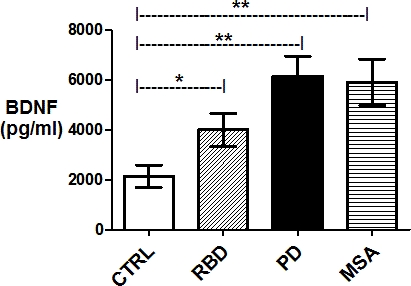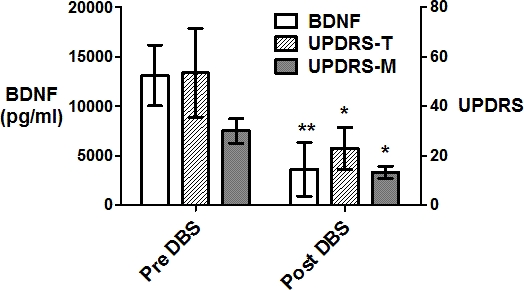Session Information
Date: Monday, June 20, 2016
Session Title: Parkinsonism, MSA, PSP
Session Time: 12:30pm-2:00pm
Objective: Evaluation of peripheral concentrations of brain-derived neurotrophic Factor (BDNF) in patients with Parkinsonian disorders and correlation with clinical measurements of disease progression to elucidate a better understanding of the role of BDNF in neurodegeneration.
Background: Current literature indicates that BDNF plays a role in the pathogenesis of synucleinopathies such as Parkinson’s disease (PD) and multiple system atrophy (MSA) due to its ability to support neuronal survival and synaptic plasticity in the brain. Evidence for local involvement of BDNF in the pathogenesis of movement disorders has been demonstrated in animal and cell culture models, but it is unknown if levels in peripheral blood are indicative of disease state. Changes in peripheral BDNF concentrations associated with neurodegeneration might also be observed in patients with a prodromal condition, REM sleep behavior disorder (RBD).
Methods: Using serum samples collected as part of an ongoing longitudinal study, BDNF was measured via ELISA from patients with PD (N = 34), MSA (N = 17), RBD (N = 12), and age-matched normal controls (N = 20).
Results: BDNF levels were significantly increased in patients with RBD (p = 0.016), PD (p = 0.002) and MSA (p = 0.003) when compared to controls, suggesting that increased serum BDNF is associated with the development of movement disorders.  We next asked if the levels of serum BDNF were associated with improvement in motor function in patients with PD following deep brain stimulation (DBS). When we compared the serum concentrations of BDNF in patients before and after DBS, we observed a significant decrease in BDNF (p = 0.0079) together with a change in motor scores demonstrating improvements in symptoms. (UPDRS-Total p = 0.025; UPDRS-Motor p = 0.026).
We next asked if the levels of serum BDNF were associated with improvement in motor function in patients with PD following deep brain stimulation (DBS). When we compared the serum concentrations of BDNF in patients before and after DBS, we observed a significant decrease in BDNF (p = 0.0079) together with a change in motor scores demonstrating improvements in symptoms. (UPDRS-Total p = 0.025; UPDRS-Motor p = 0.026).
Conclusions: These results strongly suggest that peripheral concentrations of BDNF reflect the progression of Parkinsonian disorders, as indicated by the link between clinical measurements of disease state and evident decrease in BDNF after DBS, when symptoms have been alleviated. This property suggests that BDNF might be a useful biomarker for monitoring neurodegenerative disease activity.
To cite this abstract in AMA style:
K. Csencsits-Smith, J. Suescun, A. Gonzalez, A. Actor, M. Schiess. Serum brain-derived neurotrophic factor as an indication of disease state in parkinsonism and RBD [abstract]. Mov Disord. 2016; 31 (suppl 2). https://www.mdsabstracts.org/abstract/serum-brain-derived-neurotrophic-factor-as-an-indication-of-disease-state-in-parkinsonism-and-rbd/. Accessed October 17, 2025.« Back to 2016 International Congress
MDS Abstracts - https://www.mdsabstracts.org/abstract/serum-brain-derived-neurotrophic-factor-as-an-indication-of-disease-state-in-parkinsonism-and-rbd/
